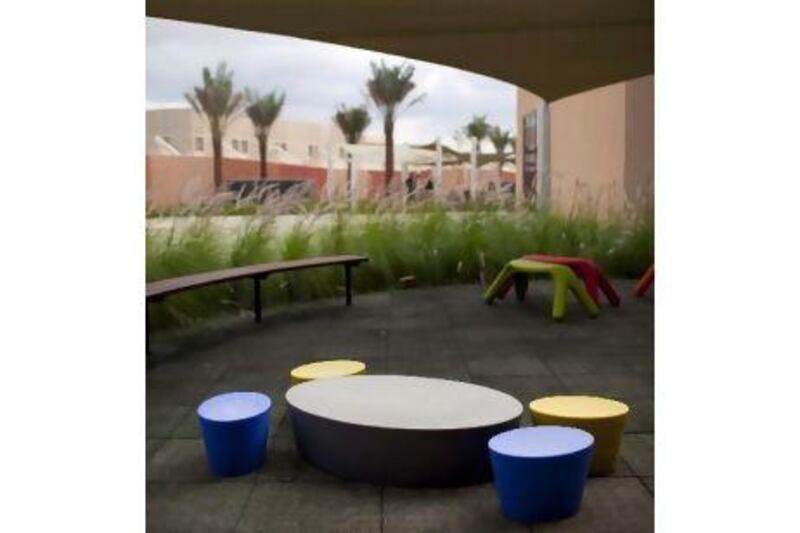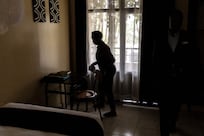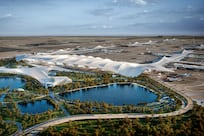Tomorrow, one of Abu Dhabi's newest and most innovative gardens will open opposite the old Al Tabbiyah cemetery, at the junction of 30th and 11th streets. A series of educational spaces dedicated to raising environmental awareness and addressing the five senses, it includes sensory gardens, play areas, outdoor classrooms and an internal shaded "eco-courtyard" complete with vertical gardens, solar panels and a remarkable steel tower that its architects, Broadway Malyan, refer to as an "eco-tree."
Like some secret garden, this contemporary hortus conclusus is hidden behind the high, angular walls of the new Mubarak bin Mohammed Cycle One School, one of five public schools that will open for the first time tomorrow. The concept behind the garden is that teachers and pupils will be able to use it as an outdoor classroom and playground where important lessons can be learnt about plants, food and the environment.
House&Home Nick's Garden
Create a sustainable garden that thrives in the desert with the help of Nick Leech.
For the teachers, staff and 1,200 pupils who are lucky enough to work, learn and play at the school, Sunday will be an exciting day indeed and the overall effect will surely be magical. They will arrive at a brand-new school, the rationale, design and construction of which represent a new chapter in Abu Dhabi's educational history and a radical departure from current institutional and architectural norms. Commissioned by the Abu Dhabi Education Council as part of a strategic plan that includes building 100 new schools over 10 years, the school's design was the result of an international competition that sought to provide a new architectural and pedagogical model for a new generation of schools.
When I visited the school in early December, an army of workers were still putting the finishing touches to the building while flocks of sparrows had already started making nests in the living walls and trees. Even from outside, architectural differences immediately catch the eye, not least the bold use of colour on the angular facade, the school's welcoming, fenceless entrance and the oversized, apple green louvers that shade the windows of its library.
A grid of date palms guides pedestrians to the entrance, creating an effect that is more leisure centre than school - appropriate given that the building will act as a community centre outside school hours.
At the heart of the scheme, the multifunctional "eco-courtyard" helps to introduce natural light into the building's core while acting as a flexible space and spill-out area for the labs, dining rooms and classrooms that surround it. Some of the largest vertical gardens I have seen in the UAE are set in niches on either side of the space. The vertical gardens are made from large PVC frames that contain hundreds of small nylon pockets, each of which holds a separate plant. Alternanthera, Portulaca grandiflora, and Sesuvium portulacastrum dominate and a line of drip irrigation feeds off a single vertical mainline to water each horizontal row of plants.
Given that the walls were planted in midsummer, they have been remarkably successful. The few patches that have suffered losses seem to have done so because of too much irrigation rather than too little, but such teething problems are to be expected.
At the centre of the courtyard is what designers refer to as the "eco-tree". A steel tower structure containing platforms, planters and a spiral staircase wrapped with a steel mesh, the structure is festooned with such vines, climbers and trailing plants as the Coral Vine (Antigonon leptopus), Vining Milkweed (Tristellateia australasiae) and True Jasmine (Jasminum grandiflora).
For Drew Kent, Broadway Malyan's landscape architect, the "tree" is one of the key spaces where outdoor lessons can take place. "The intention is to encourage students to explore the practical benefits of learning to look after plants by seeing first-hand how they grow, are harvested, and recycled. We imagine part of the science lesson could be held within the eco-tree itself."
For Kent, the planting in the vertical gardens and eco-tree actively demonstrate the important role that landscape, trees and plants can play in creating more sustainable urban environments. They help to clean and cool the air, improve humidity and provide shade in the courtyard. In doing so, they make a positive contribution to the performance of the building by helping to reduce the amount of energy it consumes.
"Landscape is often just used as a backdrop or to help create a scene but here its practical and multi-use. We've taken the resources that are poured into the landscape - the water, the planting, the maintenance - and we've used those to serve the children, the school and the learning environment as a whole."
Of all the positive roles for plants to play in the school, shade is the most important. Kent was required to shade 60 per cent of all outdoor gathering spaces and 75 per cent of all pathways and parking areas, a serious challenge from both a design and a budgetary perspective. For him, however, this provided yet another opportunity to show what plants can really do. "Trees provide a far better shading experience. They mitigate the moisture in the air and cool the wind and breezes that flow through them. If you were to sit in an exterior courtyard under an architectural shade and then under a tree, the environment would be much cooler under the tree. I think you could say that a tree can actually provide 20-30 per cent more cooling than an architectural shade would, something that is vital here in the UAE."
And it's in that statement that the real power of the school's landscape lies. In many instances, it is familiar, using a tried and rather tired palette of plants that would be familiar to any novice gardener in the UAE. However, even when this is the case, it manages to use these plants in ways that make a functional contribution to the daily lives of the people in the school. It moves beyond the ornamental and points to a future when the real value of plants is harnessed and recognised. Maybe it's time to go back to school.
Ask Nick
My houseplants get very dusty but when I try to clean them with a damp cloth, the leaves look dull and lifeless afterwards. What would you recommend for keeping them looking healthy and clean?
There are many products you can buy specifically for keeping your houseplants looking like new, including aerosol-based polishes and aerosol-impregnated wipes.
It's also possible to use common household products such as vegetable oil, liquid dish soap and even mayonnaise. However, for the best results, take your plants outdoors on a cloudy day (to avoid sunburn) and wash them down with diluted washing up liquid. Rinse off the leaves and let them air-dry. If spots appear on leaves, gently wipe them off.
If you like the look of shiny leaves, spray a light coat of leaf polish on the top surface only - and only once the leaves are clean; you don't need to wipe the leaves.





